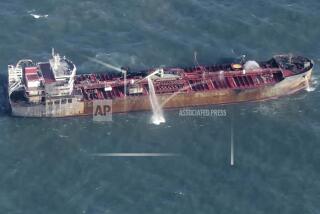Oil from 2007 spill surprisingly toxic to fish, scientists report
- Share via
Thick, tarry fuel oil disgorged into San Francisco Bay from a damaged cargo ship in 2007 was surprisingly toxic to fish embryos, devastating the herring population that feeds seabirds, whales and the bay’s last commercial fishery, scientists reported Monday.
Although the bay’s herring spawning grounds are now free of toxic oil, studies have found that the moderate-size spill of 54,000 gallons had an unexpectedly large and lethal effect.
The culprit, a common type of ship fuel called “bunker fuel,” appears to be especially toxic to fish embryos, particularly when exposed to sunlight, according to a study published Monday in the Proceedings of the National Academy of Sciences.
“That’s the big lesson,” said John Incardona, a toxicologist with the National Marine Fisheries Service. “This bunker oil is literally the dregs of the barrel, and it’s much more toxic than crude oil.”
The container ship Cosco Busan spilled low-grade bunker fuel after it sideswiped the San Francisco-Oakland Bay Bridge on a foggy November morning four years ago. This type of sludge-like fuel is cheap and thus popular among operators of commercial shipping fleets that transport raw materials and goods around the globe.
Scientists have traditionally focused on larger crude oil spills, such as last year’s Deepwater Horizon drilling rig blowout in the Gulf of Mexico or 1989’s Exxon Valdez tanker disaster, in which 11 million gallons of oil were discharged into Alaska’s Prince William Sound. The Exxon spill is suspected of wiping out the sound’s herring fishery, which has never bounced back.
From studies in Alaska, scientists knew that oil could cause heart deformities to developing herring in their embryonic sacs.
But after examining herring embryos placed in cages in shallow waters near the Cosco Busan spill site, researchers were surprised to find that nearly all had died, and their tissues were deteriorating faster than expected in the bay’s chilly water.
“We didn’t think there was enough oil spilled to cause this much damage,” said Gary Cherr, a study coauthor and director of the UC Davis Bodega Marine Laboratory. He described the total spill as similar in size to a large backyard swimming pool.
Oil and water don’t mix. The fat-filled herring egg sacs can act like little sponges, soaking up the highly toxic compounds from the bunker fuel. Once exposed to sunlight during low tides, the oil compounds became even more lethal to developing fish.
“Bunker fuel is used worldwide and is spilled relatively often,” Cherr said. “It is important to look at small spills in sensitive areas,” he added, now that science understands the lethal potential of low concentrations.
The owners and operators of the Cosco Busan in September agreed to pay $44.4 million to cover government claims, the cost of the cleanup — about half of the spilled oil was captured — and bay restoration programs. Besides tarring about 30% of the bay’s herring spawning grounds, the spill killed about 6,800 seabirds and closed beaches for months.
More to Read
Sign up for Essential California
The most important California stories and recommendations in your inbox every morning.
You may occasionally receive promotional content from the Los Angeles Times.









